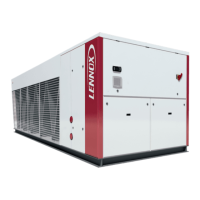• 26 •
Application Guide / NEOSYS-AGU-1801-E
Installation instructions to respect in case of variable primary fl ow:
• The hydraulic system will have to be properly designed and balanced to ensure a right water fl ow distribution through the chiller
evaporator and the terminal units.
• The hydraulic system will have to be properly designed to respect minimum and maximum water fl ow through each chiller following
the values given by the manufacturer.
Case of constant Delta P mode :
• In case of system designed with terminal units equipped with 2 way valves, the hydraulic system will need to have a bypass fl ow
to ensure a minimum water fl ow through the chiller evaporator.
Méthode de by-pass :
• Bypass adequate water fl ow can be achieved with a slow modulating opening as soon as the water fl ow rate is near the mini-
mum. When the water fl ow rises according to predefi ned setting, this valve closes. This bypass modulating valve provided by
LENNOX (contact customer service) is controlled by our Climatic control. The bypass should be positioned at the beginning of
the installation near the unit and allows signifi cant energy savings and cost as opposed to a location at the end of the system.
• An alternative is to install some 3-way valves at different points of the terminal units. This approach allows constant minimum
fl ow in the chiller or heat pump and ensures a cheaper system.
• The minimum water fl ow through the chiller evaporator will need to respect a minimum value that is 60% of the nominal chiller
water fl ow.
• The fl ow bypass from chilled water supply to chilled water return can be done with a motorized bypass valve opened via a signal
from a fl ow meter.
• For safe operation some terminals can be equipped with three way control valves in order to ensure the fl ow will not drop below
the minimum value at any load condition.
• The water fl ow must not vary by more than 10% per minute. If the fl ow rate changes more rapidly, the system should contain a
minimum of 6,5 liters of water per kW instead of 3 liters/kW.
• Check the control valve authority in low load periods, especially in case of long pipe hydraulic systems.
HYDRAULIC EQUIPMENT

